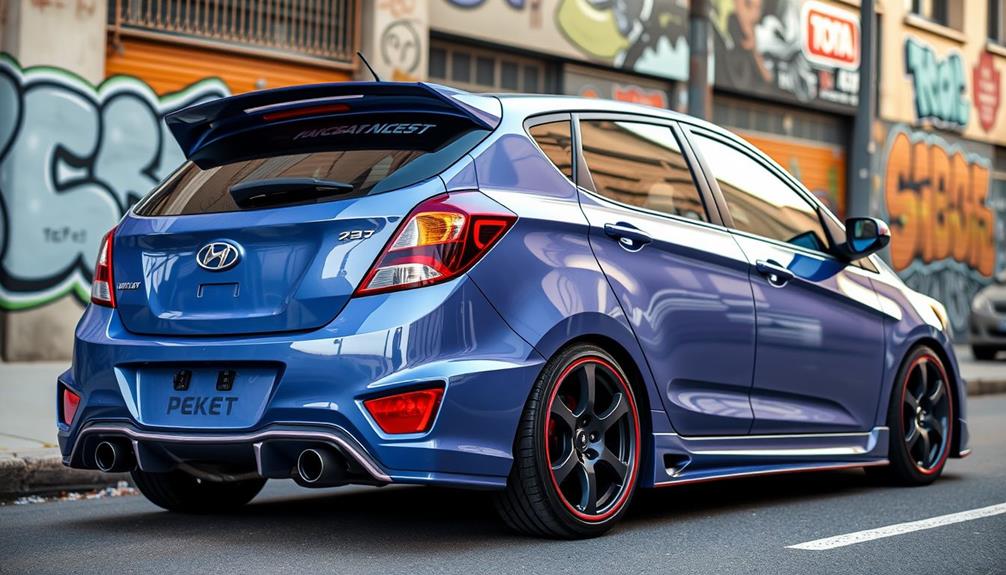Tuning your 2013 Hyundai Santa Fe can transform it into a modern performance SUV, delivering up to 300 horsepower. With options like chip tuning, you can boost power, enhance throttle response, and even improve fuel economy by 15%. Installing high-performance components, such as upgraded spark plugs, guarantees your engine runs smoothly and efficiently. Remember, it's crucial to keep original parts for potential warranty claims. The upgrade not only enhances acceleration but also makes your driving experience more enjoyable. Want to know the best approaches and community insights on tuning? There's plenty more to explore!
Key Takeaways
- Chip tuning can boost the 2.0T engine's output to 290-300 hp, enhancing overall performance.
- Improved throttle response and torque significantly enhance acceleration, especially in the critical RPM range.
- Tuning optimizes fuel economy, potentially reducing consumption by up to 15%, making it more cost-effective.
- Upgrades may require additional components like high-performance spark plugs for optimal results post-tuning.
- Active community support and insights help ensure successful tuning and installation while navigating warranty considerations.
Overview of the 2013 Santa Fe
When you look at the 2013 Hyundai Santa Fe, you'll notice it's designed to meet the needs of families and individuals alike. This versatile SUV comes in two body styles: the Hyundai Santa Fe Sport, which seats five, and a longer version that accommodates seven passengers.
You'll appreciate the choice of engines, with a 2.4L four-cylinder generating 190 hp and a 2.0L turbocharged engine pushing out 264 hp, allowing you to go from 0-60 mph in under nine seconds.
Inside, the Santa Fe emphasizes luxury and comfort, featuring high-quality materials and standard leather bucket seats. You'll enjoy advanced technology options like Bluetooth connectivity, making every drive more enjoyable.
The cargo capacity is impressive too, measuring 35.4 cubic feet with the seats up and expanding to a maximum of 71.5 cubic feet when the rear seats are folded down. This space is perfect for family trips or grocery runs.
Safety isn't overlooked either, with integrated side airbags, adjustable seat belts, and improved fuel efficiency through high-strength steel construction, ensuring you and your loved ones stay protected on the road.
Benefits of Chip Tuning
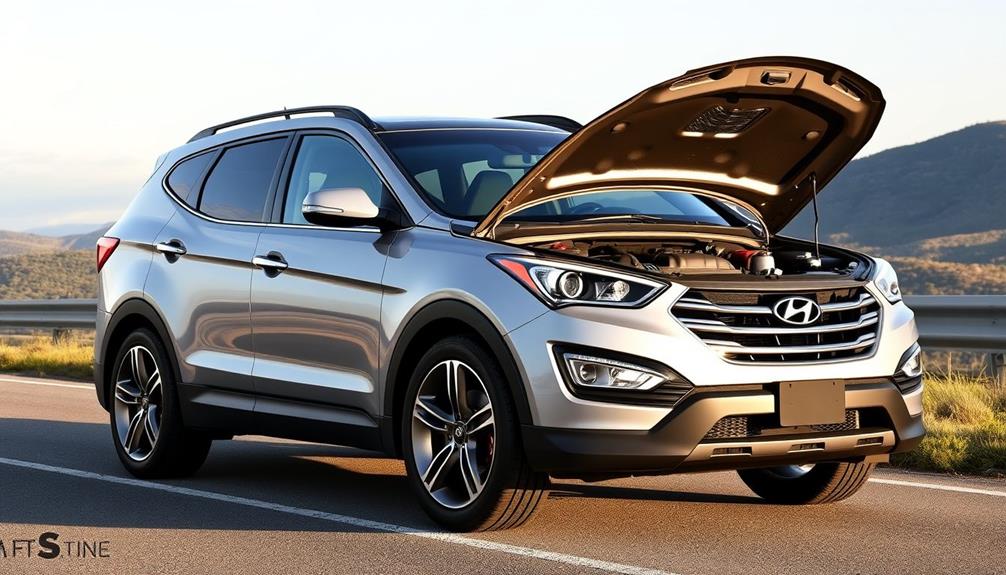
Chip tuning offers impressive benefits for your 2013 Hyundai Santa Fe, especially if you're looking to enhance its performance. By optimizing the engine's control unit, you can notably boost power and efficiency, transforming your family SUV into a dynamic driving machine.
Here are three key benefits of chip tuning:
- Increased Power Output: Chip tuning can elevate your Santa Fe's power from 264 hp to an estimated 290-300 hp, providing a thrilling driving experience.
- Improved Throttle Response: You'll notice better acceleration and responsiveness, making your daily drives more enjoyable and engaging.
- Optimized Fuel Economy: With chip tuning, you might reduce fuel consumption by up to 15%. This optimization enhances the air-fuel mixture for more effective combustion, saving you money at the pump.
While the performance gains are impressive, it's crucial to take into account potential additional components, like spark plugs, to maintain engine cleanliness.
Chip tuning often comes with a warranty, which can give you peace of mind should any issues arise.
Installation Process and Challenges
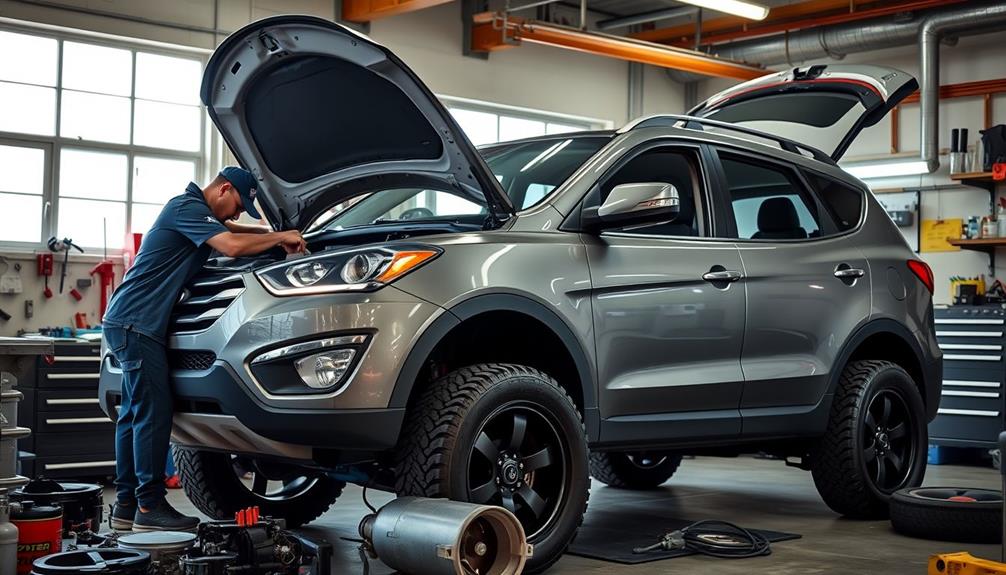
After enhancing your 2013 Hyundai Santa Fe's performance through chip tuning, you'll need to tackle the installation process, which can present its own set of challenges.
Installing tuning modules may require additional components like upgraded spark plugs and oil catch cans to maintain engine cleanliness under increased boost pressures.
While some users find the installation of performance parts relatively straightforward, careful monitoring of performance metrics post-tuning is essential. This helps you avoid issues such as oil blow-by that can arise from improper installation.
You should also consider the time investment involved, as reverting modifications for warranty claims may necessitate removing components and ensuring you retain all original parts.
Proper venting of oil catch cans is vital during this process, so following detailed installation instructions and community insights is key to a successful upgrade.
Navigating the installation process can be intimidating, but it's a necessary step to access your Santa Fe's full performance potential.
Impact on Warranty Coverage
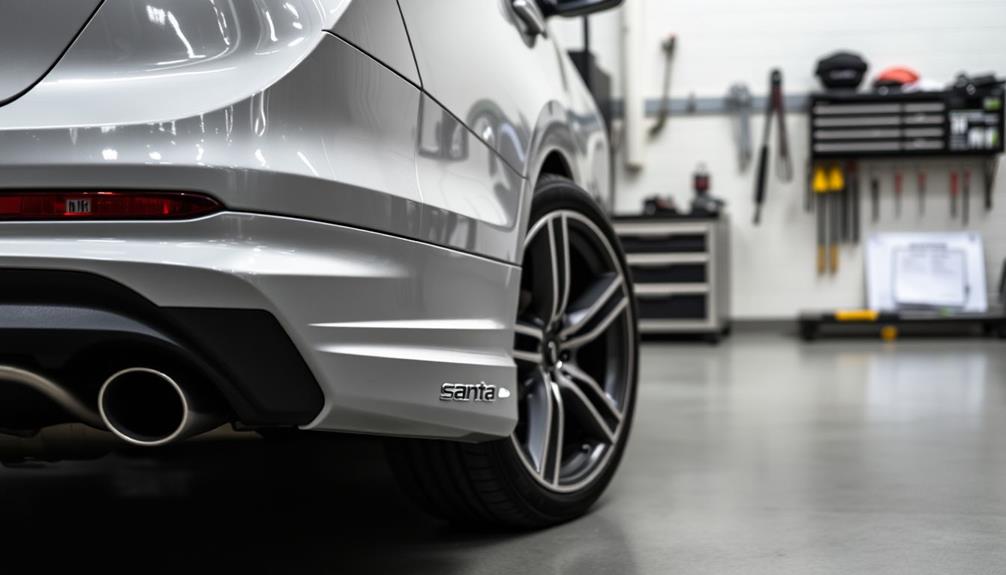
Modifications to your 2013 Hyundai Santa Fe, like chip tuning, can greatly impact your vehicle's warranty coverage.
Manufacturers often have strict policies against aftermarket modifications, which means any performance enhancements you make could void your warranty.
Here are three key considerations to keep in mind:
- Original Components: Always keep the original parts available for reinstallation. Dealers can detect tuning modifications during service checks, which might lead to warranty claims being denied.
- Unrelated Issues: Be aware that warranty denial can occur even if the modification is unrelated to the issue being claimed. Understanding your manufacturer's policies is essential to avoid unexpected surprises.
- Documentation: Thoroughly document any modifications and know your rights under warranty agreements. Some users have successfully claimed warranty benefits despite modifications, but experiences can vary greatly.
Before engaging in any performance tuning or modifications, make sure you fully understand your vehicle's warranty terms.
This awareness can help you navigate potential disputes and protect your investment in your Hyundai Santa Fe.
Understanding Torque and Horsepower
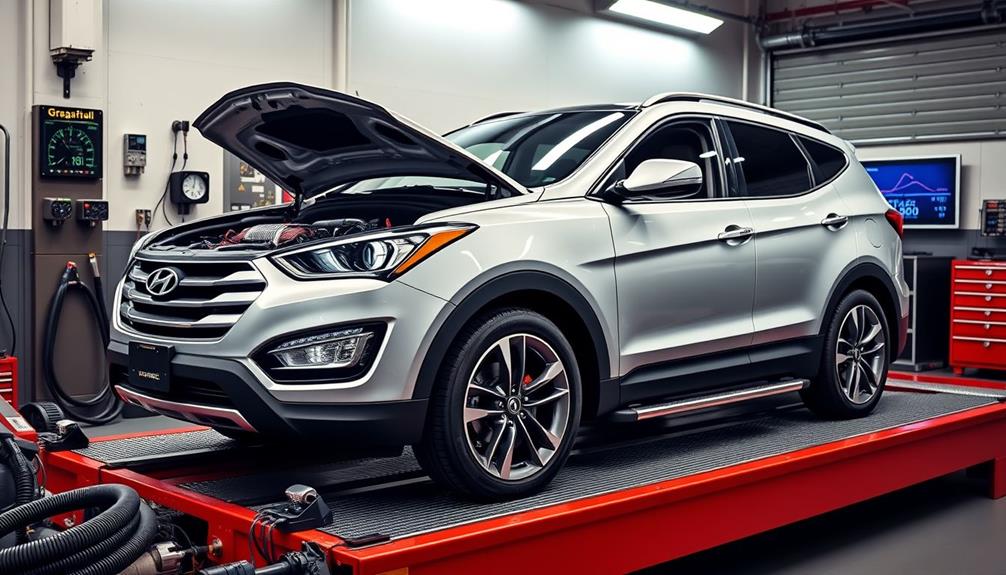
When tuning your 2013 Hyundai Santa Fe, it's important to understand the difference between torque and horsepower.
Torque is what gets you moving and makes daily driving more enjoyable, while horsepower kicks in at higher speeds.
Torque Vs. Horsepower Explained
Have you ever wondered how torque and horsepower influence your driving experience? Understanding the differences between these two metrics can help you make informed decisions about tuning your Hyundai Santa Fe. Here's a quick breakdown:
- Torque is vital for acceleration and everyday driving, especially in the 1800-3000 RPM range where the Santa Fe shines, producing 269 lb-ft of torque.
- Horsepower increases at higher RPMs and is essential for achieving top speed, but you typically drive at lower RPMs where torque's impact is more significant.
- The stock 2.0T engine offers a balance with 264 horsepower, demonstrating how both metrics contribute to performance.
When you tune your Santa Fe, optimizing the balance of fuel and air pressure can enhance both torque and horsepower.
However, keep in mind that increased turbo pressures may lead to oil blow-by issues, so consider using oil catch cans for engine maintenance.
Importance for Daily Driving
In everyday driving scenarios, the significance of torque in your Hyundai Santa Fe can't be overstated. With peak torque levels ranging from 1800 to 3000 RPM, your Santa Fe 2.0T delivers better acceleration and responsiveness in daily situations, making your commute smoother and more enjoyable.
While the stock engine produces 264 hp, tuning can push that to around 280 hp, enhancing overall performance without compromising engine longevity.
Daily driving typically occurs at lower RPMs, where torque plays a more significant role than horsepower. This is why tuning is crucial; it optimizes the balance of fuel and air pressure, maximizing both torque and horsepower for an improved driving experience.
You'll notice the difference when merging onto highways or maneuvering through city traffic, where quick bursts of power are essential.
However, increased turbo pressure from tuning can lead to potential oil blow-by issues. To maintain engine cleanliness and performance, consider using oil catch cans.
Performance Tuning Benefits
Tuning your Hyundai Santa Fe 2.0T not only enhances everyday driving but also reveals significant performance benefits by optimizing both torque and horsepower.
By focusing on performance tuning, you'll experience a noticeable difference in how your vehicle accelerates and responds to your commands.
Here are three key benefits of tuning:
- Improved Torque: Increased torque enhances acceleration, especially in the critical range of 1800-3000 RPM. You'll feel the difference during daily driving, making merging and overtaking much easier.
- Higher Horsepower: While the stock engine produces 264 hp, tuning can push that number to around 270 hp at the wheels, giving you a more spirited driving experience without sacrificing reliability.
- Enhanced Throttle Response: Effective tuning balances air and fuel pressure, leading to quicker throttle response and a more dynamic feel behind the wheel.
Additionally, optimizing boost pressure can elevate power to an impressive 290-300 hp at the crank.
Remember, using an oil catch can is also wise for maintaining engine health at higher boost levels.
Embrace performance tuning, and enjoy the newfound power your Santa Fe has to offer!
Community Feedback on Tuning

Enthusiasts are buzzing about the performance upgrades available for the 2013 Hyundai Santa Fe, particularly regarding LAP 3 tuning. Community feedback reveals a mixed reception; while some users rave about the noticeable performance gains, others are skeptical, citing a lack of visual evidence for its effectiveness.
Many have reported that aftermarket tuning options can push power levels up to 300 hp at the crank, which is impressive for a family SUV. However, proper installation is essential. Enthusiasts emphasize the importance of adding components like oil catch cans to keep the engine clean post-tuning.
When diving into these performance upgrades, it's wise to take warranty implications into account, as modifications can lead to voided coverage from manufacturers.
The Santa Fe community actively shares insights about reputable tuners, creating a supportive environment for those looking to enhance their vehicles. This exchange of knowledge helps owners make informed decisions about aftermarket tuning, ensuring they achieve the best possible results while maintaining their vehicles' longevity.
Whether you're a seasoned tuner or just starting, the collective wisdom of fellow enthusiasts can guide you through your tuning journey.
Enhancing Fuel Efficiency

Improving fuel efficiency in your 2013 Hyundai Santa Fe isn't only achievable but can also lead to significant savings at the pump. By considering chip tuning, you can optimize the air-fuel mixture, potentially reducing fuel consumption by up to 15% during travel. This means more economical long journeys for your family without sacrificing comfort or functionality.
Here are three key benefits of enhancing fuel efficiency through tuning:
- Cost Savings: With better fuel efficiency, you'll spend less on fuel, making those family road trips lighter on your wallet.
- Eco-Friendly Performance: Chip tuning balances performance with environmental considerations, allowing you to drive an eco-friendly SUV while enjoying improved power.
- Enhanced Driving Experience: Improved engine efficiency not only boosts horsepower and torque but also contributes to better mileage, ensuring a versatile driving experience for everyday use.
Investing in chip tuning can transform your Santa Fe into a more efficient, cost-effective, and enjoyable family SUV, proving that you don't have to compromise on performance to achieve excellent fuel efficiency.
Performance Specifications Post-Tuning

After tuning your 2013 Hyundai Santa Fe, you can expect impressive performance gains that truly elevate your driving experience. The 2.0T engine now delivers an estimated output of 290-300 hp at the crank, a significant boost from the stock rating of 264 hp. This enhancement translates to exhilarating acceleration and improved throttle response, with torque figures reaching around 270 hp at the wheels.
The tuning process optimizes the air-fuel mixture, which not only enhances engine efficiency but can also reduce fuel consumption by up to 15%. To guarantee your engine performs reliably under increased boost pressure, you may want to take into account installing high-performance spark plugs and oil catch cans. These components help maintain engine cleanliness and longevity.
Users frequently report that tuning the Santa Fe doesn't just elevate horsepower; it also transforms the exhaust sound and elevates overall driving dynamics.
You'll find your SUV feels sportier and more responsive, making every drive an engaging experience. With these performance specifications post-tuning, your Hyundai Santa Fe will no longer be just a family SUV; it'll be a thrilling ride that meets your need for speed.
Market Position and Competitiveness

The 2013 Hyundai Santa Fe stands out in the competitive SUV market thanks to its impressive tuning potential, making it a top choice for those who crave both performance and practicality.
With a base price starting at $28,350, the Santa Fe delivers luxury features and performance enhancements that resonate with today's consumers.
Here are three key aspects that enhance its market position:
- Power Boost: Aftermarket tuning can increase the Santa Fe's output to around 290-300 hp, appealing to performance-oriented buyers.
- Turbocharged Option: The turbocharged engine, rated at 264 hp, serves as a solid foundation, allowing for safe tuning to approximately 280 hp.
- Active Community: The growing interest in performance upgrades within the Santa Fe community indicates a vibrant market, further boosting its appeal.
These factors collectively position the Santa Fe as a competitive choice among SUVs, offering a sportier driving experience without sacrificing practicality.
Frequently Asked Questions
Can You Tune a Hyundai Santa Fe?
You can't currently tune the Hyundai Santa Fe 2.0T, but similar models offer tuning options. When available, expect enhanced performance and power, though be cautious of potential warranty issues and necessary additional components for ideal results.
Can You Chip a Hyundai Santa Fe?
Chipping a Hyundai Santa Fe's like opening a treasure chest; you reveal hidden potential. While direct chip options are limited now, tuning solutions for similar models suggest exciting possibilities for performance upgrades in the near future.
How Many Miles Can a 2013 Hyundai Santa Fe Last?
Your 2013 Hyundai Santa Fe can last between 150,000 to 250,000 miles with proper maintenance. Regular oil changes, fluid checks, and timely service will help you achieve its full potential and guarantee reliable performance.
Does 2013 Santa Fe Have Sport Mode?
The 2013 Santa Fe doesn't deliver a dedicated sport mode, but you can still savor spirited driving with its manual shift feature. Enjoy enhanced control and performance, especially with the turbocharged engine's impressive power.
Conclusion
In summary, tuning your 2013 Hyundai Santa Fe can transform your family SUV into a powerhouse of performance and efficiency. With the right chip tuning, you'll experience a thrilling boost in torque and horsepower, making every drive feel like an exhilarating adventure. While it's essential to take into account warranty implications, the benefits often outweigh the challenges. Join the community of satisfied tuners, and watch your Santa Fe dominate the road like a sports car in disguise! If you’re considering family SUV tuning, it’s important to do your research and consider all options before making any modifications. Look for reputable sources of information and consider seeking professional advice to ensure you get the best results for your Santa Fe. By following these family SUV tuning tips, you can take your driving experience to the next level and enjoy the full potential of your Hyundai Santa Fe.


